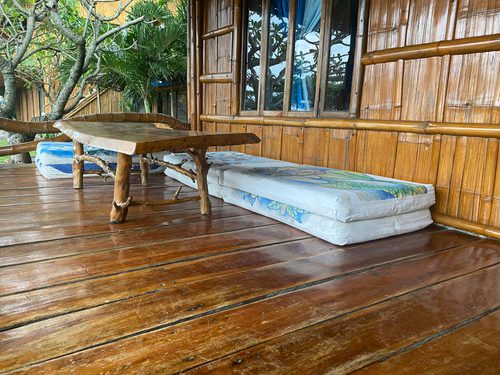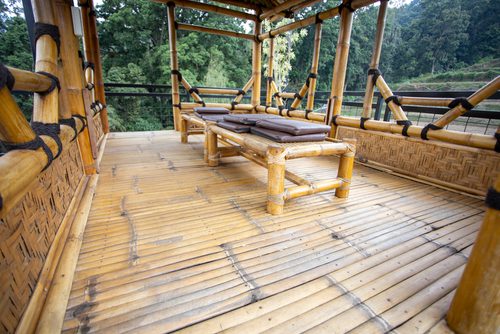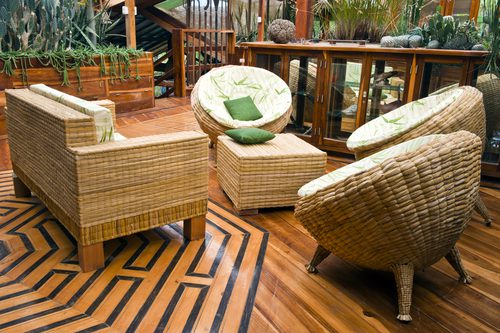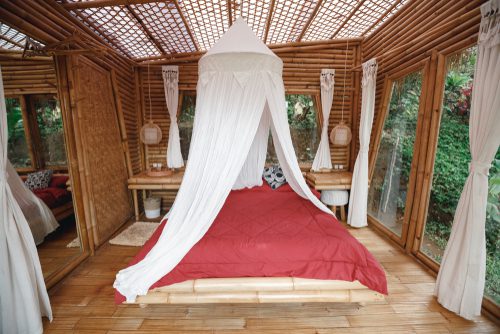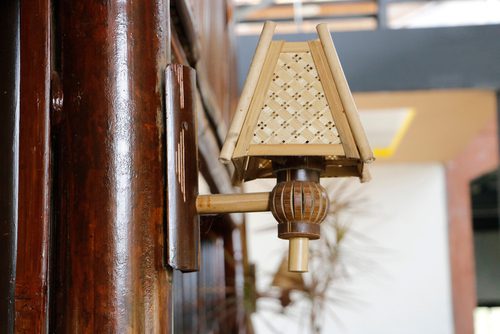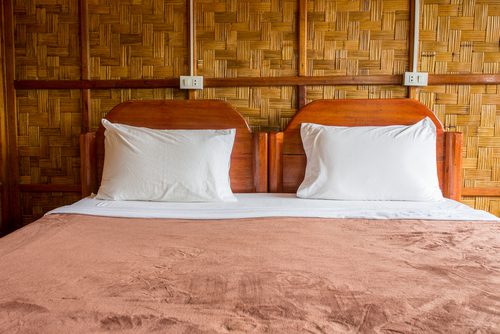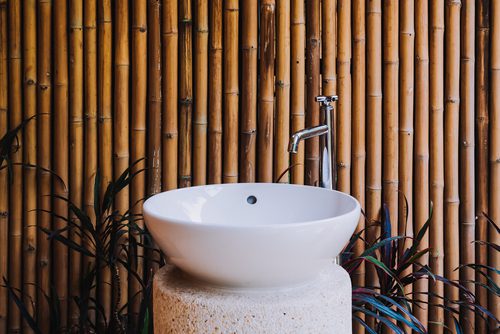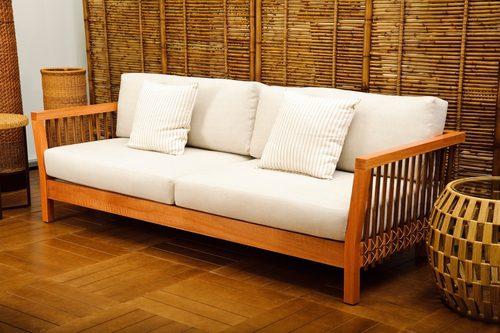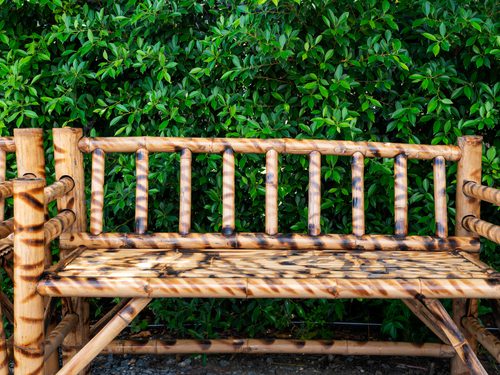Bacon’s asthma meant that he was pronounced unfit for active service in the Second World War. He did, however, volunteer for a role in Civil Defence where he worked in ARP (Air Raid Precautions).
Bacon was intrigued by the poems of T S Eliot, whose play The Family Reunion led him to a far richer source of ideas and sensations, The Oresteia by the ancient Greek dramatist, Aeschylus.
In late 1943 Bacon moved into the ground floor of 7 Cromwell Place, South Kensington, a house once owned by the Pre-Raphaelite painter John Everett Millais. Its cavernous moth-eaten grandeur provided an appropriate backdrop for an illicit casino run by Bacon and Lightfoot. It was in this space that Bacon completed a painting that finally launched his name, a work that unnerved its first audience.
Three Studies for Figures at the Base of a Crucifixion, 1944 was hung in a group exhibition at the Lefevre Gallery, New Bond Street in April 1945, mere weeks before the end of the war in Europe. Figure in a Landscape, 1945 was also included but it was the Three Studies that rivetted the attention of public and critics. The triptych, with its hot orange background and stone-coloured monsters of vaguely human descent, left a lasting and disquieting impression. Despite its title, the figures were inspired by the Furies, mythical agents of revenge who pursued Orestes in Aeschylus’s tragedy. The painting was bought by Eric Hall, who later presented it to the Tate Gallery.
The following year Bacon realised a work of unparalleled ambition. Painting, 1946 came about through an unlikely series of transformations. Bacon claimed that it began as an attempt to paint a bird alighting on a field but ended as an assemblage of meat carcasses and a mutilated, almost headless man beneath an umbrella. The artist Graham Sutherland, at that time a close friend of Bacon, was greatly impressed by the work, so much so that he insisted that the dealer and artist, Erica Brausen contact Bacon immediately. She bought the work in early autumn and it was displayed in several group exhibitions, including a show of 20th century art at the Musée d’Art Moderne, Paris, in November 1946, before being acquired by the Museum of Modern Art, New York, in 1948. Bacon would remain with Brausen’s Hanover Gallery for the next 12 years, but did not mount a one-man show there until November 1949.
Within weeks of selling Painting, 1946, Bacon was on his way to Monte Carlo. There he gambled recklessly and sometimes with considerable success. He spent large parts of the next few years on the Côte d’Azur, often with Eric Hall. The climate eased his asthma, the nightlife catered to his desires and the landscape set him thinking. The intense, unflinching light, which impressed the artist, also made it difficult for him to paint. In fact, he scarcely completed any paintings while abroad (no works survive from 1947) and when faced with an imminent deadline, would accomplish the greater part of his work in London. This did not deter him from imploring the Sutherlands to visit and even work in Monte Carlo, which they did in 1947.
While Bacon sent letters to Brausen reassuring her that he was busy at work and, naturally, that he needed additional funds, he had next to nothing to show for himself. As his first one-man show approached, he returned to London and rapidly built up a body of work. The lack of time had a direct impact on what Bacon produced. The works were simpler, reduced with one exception to a single figure and far more focused in expression, dwelling on significant and disturbing details such as open mouths, teeth, ears and safety pins. Head I, 1948, with its restricted palette of greys and blacks established an ideal precedent for an artist now in a hurry. His subsequent works departed from it in one vital respect; they were painted on the unprimed or ‘wrong’ side of the canvas rather than on hardboard. Bacon began working in this way while still in Monte Carlo. According to Bacon, he had used up all his primed canvases and decided, perhaps out of desperation, to take one off its stretcher and try working on the other side. He found the raw canvas held the paint with more bite, enhanced its texture and allowed thinner applications to soak into the canvas. The indelibility of each mark raised the stakes, the medium’s intractability posed a rewarding challenge, and Bacon found a technique precisely attuned to his temperament. He continued painting on the unprimed side, though the reverse was always primed, till the end of his life.
One painting stood apart from its monochrome companions in the 1949 exhibition. This was Head VI, 1949, with its sensuous purple cape. It was a variation on Velázquez’s Portrait of Pope Innocent X, 1650, a theme he mined with obsessive intensity throughout the following decade and intermittently in the 1960s. His experience of the Velázquez was entirely by way of reproductions, a dependency that, far from limiting the artist, encouraged him to take extravagant licence. Another of his primary sources was a still of the Screaming Nurse from Eisenstein’s film, Battleship Potemkin, 1925. Bacon fused the scream and Pope to memorable effect in this and later works, but especially in an imposing canvas from the following year, Study after Velázquez, 1950. This was long presumed destroyed, but was recovered by the Estate of Francis Bacon nearly 50 years after it was painted.In 1951 and again in 1952 Bacon sailed out to South Africa where his mother had moved after his father’s death. His sisters Ianthe and Winnie had settled in neighbouring Southern Rhodesia (modern Zimbabwe). During both visits, the artist was struck by the sight of wild animals moving through the long grass, a sensation he conjured up in several canvases of 1952, notably Study of a Figure in a Landscape, 1952. On his first voyage back in 1951, he stopped off for a couple of days in Cairo. Bacon held ancient Egyptian art in enormous admiration and later asserted that its achievement had been unsurpassed. From 1953 to 1954, he painted four works based on the great Sphinx.
In those same two years Bacon depicted men in suits within dark, suggested surroundings. The series of seven paintings, Man in Blue I-VII, 1954, was his most reductive treatment of the subject and was inspired, in part, by a man who had modeled for the artist in the Imperial Hotel, Henley-on-Thames.
Bacon had also had begun to tackle the nude in a more forthright manner. He painted Two Figures, 1953, and in the following year Two Figures in the Grass, 1954. The coupled male nudes from both works are derived from Eadweard Muybridge’s, The Human Figure in Motion, 1901, a volume of sequential photographs of the body in action. The Human Figure in Motion became an indispensable visual dictionary for Bacon. Its companion volume, Animals in Motion, 1899 provided visual templates for his paintings of dogs, such as Dog, 1952.
In his paintings of Two Figures, the poses were based on Muybridge’s images of wrestlers, but manipulated to more personal and sexual ends. Bacon was aware of the ambiguity between the movements of wrestlers and lovers, acutely so, since his own love life had recently taken an obsessive and masochistic turn.
By 1950, Eric Hall was no longer living with Bacon, though he had left his wife and children, and later bought and donated Dog, 1952, to the Tate. Bacon left Cromwell Place after the death of Nanny Lightfoot on the 30th April 1951, an event that traumatised him. Over the next ten years he moved from studio to studio, most of them borrowed or strictly temporary. Among those friends who obliged with a room were Peter Pollock and Paul Danquah who lived in Battersea. Sometime before 1952, Bacon became involved with the former fighter and test pilot, Peter Lacy. Their relationship was a potent mixture of the compulsive and destructive, and Bacon remained in thrall to Lacy’s neurotic sadism for much of the decade.
When Lacy moved to Tangier in the mid-1950s, Bacon followed him. For the next few years he divided his time between Morocco and London, where his circle of friends ranged from Soho luminaries such as Muriel Belcher, John Deakin, John Minton, Michael Andrews and Frank Auerbach to the literary salons of Ann Fleming and Sonia Orwell. He got on well with Robert and Lisa Sainsbury, who became exceptionally loyal patrons. In Tangier he struck up friendships with Allen Ginsberg and William Burroughs, but predictably accomplished little while actually there.
His international reputation, however, continued to grow. In 1954 he exhibited with Ben Nicholson and Lucian Freud in the British Pavilion at the Venice Biennale. When in Rome (he failed to attend the Venice Biennale), he deliberately avoided seeing Velázquez’s Pope Innocent X in the flesh. He had his first one-man show in New York at Durlacher Brothers in 1953 and his first in Paris, at the Galerie Rive Droite in 1957.
By 1957 Bacon’s painting was undergoing a transformation in handling and colour, that much became dazzlingly apparent at his exhibition at the Hanover Gallery in March that year. There he presented six paintings inspired by Van Gogh’s The Painter on the Road to Tarascon, 1888 (destroyed during the Second World War), including one painted the year before. The next three works were made in a tremendous hurry to meet the show’s deadline and the remaining two added sometime later. Necessity accelerated a process already in train; Bacon’s application of paint became coarser, his impasto thick and ridged, and his colours far more strident in range and hue. Van Gogh was one stimulus, the Céret works of Chaim Soutine and the fierce light of Morocco were two others. It was a decisive break with the ghostly forms and sombre backgrounds of the first half of the 1950s, and a permanent one.
What followed was a period of transition. He signed a contract in October 1958 with Marlborough Fine Art after its directors had offered to take on the considerable debt of £1,242 he then owed to the Hanover Gallery. Bacon respected the eye of Marlborough’s co-founder Frank Lloyd, and his day-to-day affairs were handled by the gallery’s Valerie Beston. Three years later, in 1961, he took over 7 Reece Mews, a converted coach house in South Kensington, just around the corner from his old studio at Cromwell place. The first floor studio was to be the most important room in the artist’s life. Over the years it became an overwhelmingly cluttered space with vibrant daubs and accretions of paint on the walls and doors. Its layers of dust, debris and toxic pigments could only have exacerbated his chronic asthma. In later life, despite occasionally acquiring new and more spacious places to work, he always returned to this awkward but familiar room. The studio became Bacon’s complete visual world. Its heaps of torn photographs, fragments of illustrations and artist’s catalogues provided nearly all of his visual sources. He had all but given up painting from life.
Within months of moving into Reece Mews, he produced his first large-scale triptych, Three Studies for a Crucifixion, 1962 (198.2 × 144.8 cm). He readily admitted that it was painted during an unusually booze-fuelled fortnight, a working method that rarely delivered results, but in this case liberated him. Throughout the next three decades Bacon used large-scale triptychs to address some of his grandest and most ambitious subjects.
Three Studies for a Crucifixion was included along with 90 other works in a major retrospective at the Tate Gallery in May that year. The show established his preeminence among contemporary British painters but also marked a time of personal loss. On the opening day, amidst telegrams of congratulation, one message informed him of the death of Peter Lacy in Tangier. He had parted company with Lacy some years before, and his death from drink had not been difficult to predict, yet Bacon was nonetheless deeply affected. In 1963 he painted the dark and ambiguous Landscape near Malabata, Tangier in memory of Lacy’s final resting place.
Towards the end of 1963 a new man entered Bacon’s life. George Dyer was a dapper Eastender with a petty criminal past and a tough look that belied a depressive and insecure nature. Mainly through the medium of John Deakin’s photographs, Dyer became a recurrent subject of Bacon’s paintings in the 1960s.
Photography itself became an indispensable means to Bacon’s expressive ends. Deakin’s photographs of other close friends, Henrietta Moraes, Isabel Rawsthorne, Lucian Freud and Muriel Belcher allowed the artist to capture the vitality of his subjects while keeping a critical distance. He would twist their features and practice his ‘injuries’ without having to contend with the judgment of the sitter (a problem he encountered at least once in the 1950s). Through photographs and other reproductions he could continually expand his repertory of attitudes and poses but return again to the source that inspired him. He didn’t simply confine his interest to what an image contained; he was keenly receptive to its physical state. The origins of certain painterly distortions in his canvases can be found in the tears, creases and paint accretions on prints and book pages littered across the studio floor. As Bacon himself remarked, ‘don’t forget I look at everything.’
Bacon looked at everything and was all the more critical as a result. Other painters, notably Abstract Expressionists, got short shrift or a withering rebuke. One living artist for whom he had great respect was the Swiss sculptor and draughtsman, Alberto Giacometti, though Bacon’s approval was largely confined to his drawings. The two met several times during preparations for Giacometti’s retrospective in the Tate in 1965 but Giacometti’s death, the following year, left little time for their friendship to develop.
Bacon excelled as an artist during this period. From the opening years of the decade, he achieved a new level of virtuosity in paint. Passages of bravura brushwork and whipped up impasto were combined with delicate impressions of corduroy and cloth, and trails of paint squeezed directly from the tube. His backgrounds were frequently composed of bright, flat expanses of colour, and his larger compositions displayed a tireless invention. The effect could be, by turns, playful (George Dyer Riding a Bicycle, 1967) or menacing (Triptych Inspired by T S Eliot’s Poem ‘Sweeney Agonistes,’ 1967). In 1968 the artist went to New York for the first time, to an exhibition of his recent paintings at the Marlborough Gallery. While American critical opinion remained divided over the artist, the twenty works sold within a week. The show included some of his latest portraits of Dyer, replete with a host of visual puns and games, but the relationship itself was running out of fun. The strains had been there for some time. Dyer’s lack of purpose and worsening alcoholism, his sporadic suicide bids, the frequency and savagery of the rows and Bacon’s thwarted attempts to persuade him to live outside London (Dyer always returned) all told. In 1971, matters descended into farce when Dyer tried to frame his lover for possession of cannabis by hiding 2.1 grams of it in his studio. Bacon was acquitted at trial. The artist now set his sights on a retrospective exhibition at the Grand Palais in Paris, an honour exceptional for a living painter. Two nights before the opening of the show, and in cruel symmetry to Bacon’s experience at the opening of the Tate retrospective in 1962, Dyer was found dead from a drink and barbiturate overdose in a bathroom at the Hôtel des Saints-Pères. Bacon seemed to take the news with a strange detachment. A series of paintings made over the next few years record the true strength of his grief. These include the so-called black triptychs, such as In Memory of George Dyer, 1971, and Triptych August 1972. The bleakest and perhaps the greatest of these testaments is Triptych May-June 1973, a work of monumental and grave simplicity in which the circumstances of Dyer’s death are re-enacted.
Bacon spent considerable periods of time in Paris during the 1970s, and in 1974 bought a flat on rue de Birague, near the Place des Vosges. For the next decade and a half he was able to renew and deepen his friendships with Michel Leiris, Nadine Haim and Jacques Dupin. Bacon’s 1976 portrait of Surrealist author and critic Michel Leiris, a diminutive work of subtlety and insight, is among the finest he ever painted. The following year an important exhibition of his recent works was hosted at the Galerie Claude Bernard in Paris.
Bacon’s own recorded outlook on his life and work was first published in book form in 1975. Based on a series of interviews conducted with David Sylvester between 1962 and 1974, it was further expanded in 1980 and again in 1987. The interviews afforded Bacon an unusual degree of influence over the reception and discussion of his works. Annotated typescripts, found in the studio after his death, indicate that he even had a role in their editing. In his public utterances, Bacon placed heavy emphasis on the role of chance and accident in his work The evidence of the studio suggests that Bacon was a more deliberate artist than he cared to admit. He jotted down ideas for paintings in a cryptic and allusive style, frequently invoking the imperative as if the notes were exhortations. He outlined compositions in biro, paint and felt-tip on paper, over-painted and traced existing photographs to define and explore motifs. The photographs were sometimes of his own paintings and through these he sought to develop and improve works already out in the open. In the year that the interviews were first published, The Metropolitan Museum of Art, New York, mounted an exhibition highlighting Bacon’s more recent works. The catalogue featured excerpts from recorded conversations with the American photographer, Peter Beard, who also sent the artist numerous and beautiful photographs of African wildlife. Among the 36 paintings exhibited at the show, George Dyer’s presence loomed heavily but Bacon, while prey to feelings of guilt, moved on. In the mid-1970s he met John Edwards, another good looking Eastender, then helping his brothers to manage three pubs. Bacon’s relationship with Edwards was essentially a paternal one and its stability was largely due to the self-possession and affability of the younger man.Over the course of the next fifteen years, solo exhibitions and retrospectives of Bacon’s work were held around the world. These spanned several continents, from Madrid and Barcelona in 1978 to Tokyo, Kyoto and Nagoya in 1983 and Washington DC in 1989. In 1985 the Tate Gallery, London again held a major retrospective, this time with 125 works and the director’s statement that the artist was the ‘greatest living painter’. Three years later a retrospective of just 22 works was held in the New Tretyakov Gallery in Moscow. It was the first show by a major Western artist to be mounted in the Soviet Union.
As Bacon entered his seventies his work continued to evolve. He met the challenge of landscape, which he had largely avoided since his Van Gogh works of 1957. The paintings, such as Landscape, 1978, and A Piece of Waste Land, 1982, were deliberately enigmatic, being isolated segments of landscape without scale. The title of the latter work contains a surprisingly literal allusion to T S Eliot’s The Wasteland, yet the image, with its diagrammatic arrows, is pointedly unspecific. In Jet of Water, 1979 and Sand Dune, 1981, the quasi-industrial settings are about to be engulfed by either a sandstorm or a sudden explosion of water.
During the 1980s, Bacon simplified his pictorial language, paring it down to its essentials. The human body was savagely abbreviated to a stump and a pair of legs (Study of the Human Body, 1982) or starkly implied by its residue (Blood on the Floor–Painting, 1986). His technique became, if anything, more nuanced and refined. Aerosol spray paint was used to create granular, gauze-like surfaces with the suggestion of bruising and medical trauma. His palette divided between paintings with searing red/orange backgrounds and those with a cooler tonality of greys, creams and pale blues. Among the most impressive achievements of his last decade were two portrait triptychs, Three Studies for a Portrait of John Edwards, 1984 and Study for Self-Portrait, Triptych, 1985-6. Both paintings conveyed a quality not often associated with the artist: an imposing sense of calm. Bacon, however, had not given up on desire. In his last years and in declining health (a cancerous kidney was removed in 1989), he enjoyed a passionate relationship with a cultivated young Spaniard, whom he had met sometime in 1987. Against his doctor’s advice Bacon made a trip to Madrid in April 1992. Within days of arrival he fell critically ill and was taken to a medical clinic. On the 28th of April, he suffered a heart attack and died in the presence of two nuns from the Servants of Mary. Bacon was trenchant in his atheism but there is no evidence that he resisted the care of the religious, as several times before he had been treated by sisters at the same clinic. Bacon’s remains were cremated in Spain and, as he requested, there was no service. His ashes were transported to England where they were scattered in a private ceremony. Bacon named John Edwards as the sole heir to his estate.
In the Reece Mews studio, a final portrait stood incomplete on a tall easel. It had been there since the previous November where it was observed by his sister Ianthe. The identity of its subject, the assertive profile caught half way between a self-portrait and a portrait of George Dyer, has so far defied resolution.
International exhibitions of Bacon’s paintings have continued throughout the 1990s and beyond. The most prominent of these have been in the Museo Correr, Venice (1993), the Centre Georges Pompidou, Paris (1996), the Hugh Lane Gallery, Dublin (2000), the Gemeentemuseum, The Hague (2001), Museo Serralves, Portugal (2003), the Kunsthistorisches Museum, Vienna (2003), the Institut Valencia, Valencia (2004), the National Galleries of Scotland, Edinburgh (2005), K20 Kunstsammlung, Nordrhein-Westfalen, Düsseldorf (2006), the Palazzo Reale, Milan (2007), Tate Britain, London (2008) and the Museo Nacional del Prado, Madrid (2009). In 1998 The Estate of Francis Bacon unveiled paintings previously unseen or assumed to have been destroyed, including Study after Velázquez, 1950.
The studio, where Bacon had worked for over thirty years of his life, was donated by John Edwards to the Hugh Lane Municipal Gallery of Modern Art, Dublin in 1998. It was reconstructed in the Gallery and opened to the public in May 2001.




